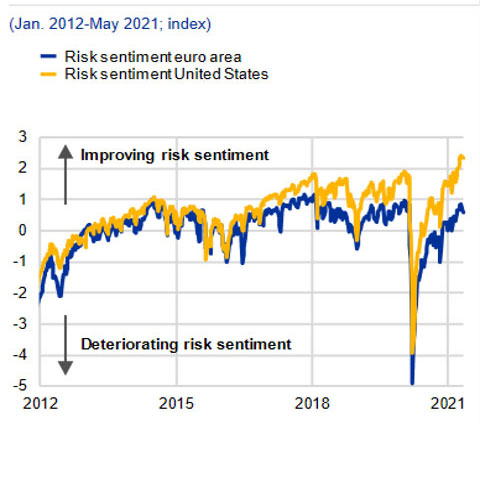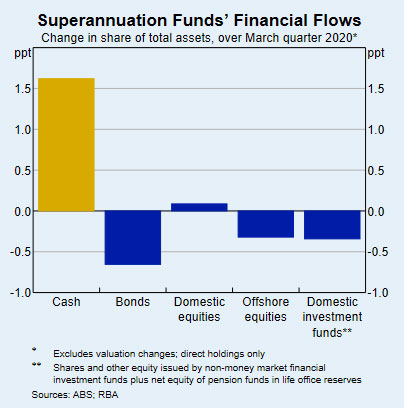The divide between risk and return has never been starker. Major equity markets are hovering around record highs even as another COVID-19 outbreak has shut down large parts of the Australian economy.
This is not a new phenomenon.
Even back in May, the European Central Bank warned that equity markets were showing "remarkable exuberance" despite higher expectations for long-term inflation.1
Figure 1: Risk Sentiment Indices

Source: European Central Bank. (2021). Financial Stability Review, May 2021.
But while many investors in "fear of missing out" are diving into the market, others are preparing for a possible downturn. VIX (an implied volatility index on the S&P 500), often referred to as a fear index, was at 23.5 on 20 August 2021. At this level, it is six points (or 34%) higher than its 50-day moving average (17.5).
Risk may be rising, but it has not yet crystalised. It gives investors a chance to review some key lessons to avoid making the same type of mistakes that have destroyed portfolios in past crises.
1. Falling markets encourage poorly timed investment switches
The initial COVID-19 crisis in March 2020 highlighted how pressure can prompt poor decision-making, such as shifting to cash after markets have fallen.
Super funds increased their aggregate cash holdings by $51 billion over the March 2020 quarter—about half of that was caused by members switching from higher-risk investments into cash, according to the RBA.2
While this was the equivalent of around 1.5% of the industry's funds under management, some large funds recorded flows of 3% to 4% into cash and one medium-sized fund recorded 8%.
Figure 2: Superannuation Funds' Financial Flows

Unfortunately for the investors who switched away from equities, by trying to time the market they missed out on one of the fastest and strongest market rebounds in history.
Many investors are again susceptible to this risk as they readjust to a life of lockdowns thanks to COVID-19.
If markets were to sharply fall again, investors already under pressure are likely to switch to cash at just the wrong moment.
2. Retirees must be prepared as they're already carrying more investment risk
Retirees have watched returns from traditionally "safe" investments such as term deposits and cash wither away as interest rates have fallen to record lows.
Many have been forced to invest more aggressively to maintain an income, but this has also left them more exposed to the impact of volatility and market downturns. This is known as sequencing risk.
There are two key reasons. Older investors usually don't have the same amount of remaining time in the market as younger investors who get the full benefit of an eventual market upswing. The impact is compounded when retirees draw down on their savings after its value has dropped.
While market downturns get most of the attention, extreme volatility can have a similar negative impact. As we have seen, it can also prompt investment switches given that retirees tend to be more loss-averse than younger investors.
Retirees need to be aware of the risks they face and set up long-term strategies that can weather the bad times as well as the good.
3. Don't assume future crises will resemble the past – they will be different
Crises have historically struck every seven to 15 years over recent decades—just long enough to forget that each one has its own drivers and unique outcomes for investors.
The COVID-19 downturn of 2020 was prompted by a health issue that locked down economic activity, causing a short, sharp downturn and unexpected quick recovery.
It was drastically different from the global financial crisis of 2007-2010, which was prompted by lax lending that almost derailed the entire banking system.
Investors experienced something very different—a long drawn-out economic and equity market recovery that took years. The dot-com boom in the late 1990s also had its own driver—a rising mania for technology stocks which was burst by rising interest rates. That time around the crisis produced mixed results—a relatively quick economic recovery but a longer equity market rebound that took years.
Every crisis is different. It's easy to forget when hindsight is 20/20.
No one can predict the future, but we can estimate risk and undertake strategies that protect against it.
With risk and uncertainty again rising, investors need to reassess their strategies ahead of any market shocks, in whatever form they take.
Milliman's SmartShield is one such strategy that can effectively smooth market volatility and provide some downside protection when markets fall (see Figure 3).
This protection is applied dynamically as market conditions change using futures contracts.
It means investors can maintain their exposure to the market through separately managed moderate, balanced, growth and high-growth accounts while taking comfort in the knowledge that downside protection will kick in when needed.
Figure 3: SmartShield Performance Since Inception
For more information about SmartShield Managed Accounts go to https://au.milliman.com/en/
FOR INVESTMENT PROFESSIONAL USE ONLY
Milliman Pty Ltd ABN 51 093 828 418 AFSL 340679 (Milliman AU) for provision to Australian financial services (AFS) licensees and their representatives, [and for other persons who are wholesale clients under section 761G of the Corporations Act]. Not for public use or distribution. Past performance is not indicative of future results. Recipients must make their own independent decisions regarding any strategies or securities or financial instruments mentioned herein. Milliman does not make any representations that products or services described or referenced herein are suitable or appropriate for the recipient. Many of the products and services described or referenced herein involve significant risks, and the recipient should not make any decision or enter into any transaction unless the recipient has fully understood all such risks and has independently determined that such decisions or transactions are appropriate for the recipient. Any discussion of risks contained herein with respect to any product or service should not be considered to be a disclosure of all risks or a complete discussion of the risks involved. The recipient should not construe any of the material contained herein as investment, hedging, trading, legal, regulatory, tax, accounting or other advice. The recipient should not act on any information in this document without consulting its investment, hedging, trading, legal, regulatory, tax, accounting and other advisers. Milliman does not ensure a profit or guarantee against loss. Materials may not be reproduced without the express consent of Milliman.
1European Central Bank (2021). Financial Stability Review, May 2021. Retrieved 1 September 2021 from https://www.ecb.europa.eu/pub/financial-stability/fsr/html/ecb.fsr202105~757f727fe4.en.html.
2Reserve Bank of Australia (April 2021). What Did 2020 Reveal About Liquidity Challenges Facing Superannuation Funds? Retrieved 1 September 2021 from https://www.rba.gov.au/publications/fsr/2021/apr/pdf/box-c-what-did-2020-reveal-about-liquidity-challenges-facing-superannuation-funds.pdf.
